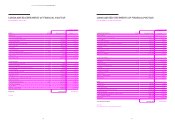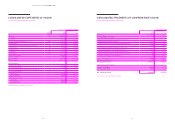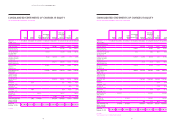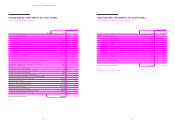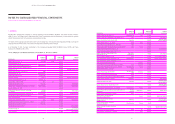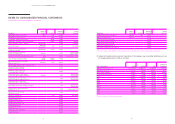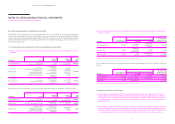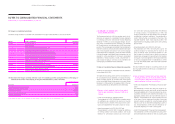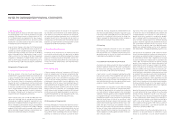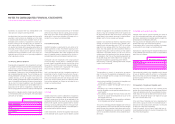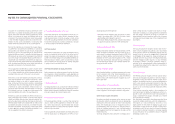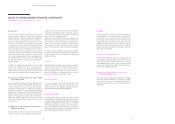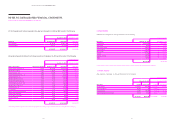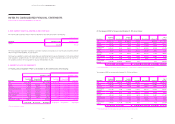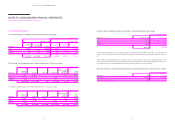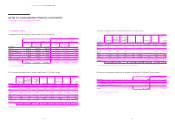Hyundai 2015 Annual Report Download - page 52
Download and view the complete annual report
Please find page 52 of the 2015 Hyundai annual report below. You can navigate through the pages in the report by either clicking on the pages listed below, or by using the keyword search tool below to find specific information within the annual report.
HYUNDAI MOTOR COMPANY Annual Report 2015
102 103
the former owners of the acquiree and the equity interests
issued by the Group in exchange for control of the acquiree.
The consideration includes any asset or liability resulting from
a contingent consideration arrangement and is measured at
fair value. Acquisition-related costs are recognized in profit
or loss as incurred. When a business combination is achieved
in stages, the Group’s previously held equity interest in the
acquiree is remeasured at its fair value at the acquisition date
(i.e. the date when the Group obtains control) and the result-
ing gain or loss, if any, is recognized in profit or loss. Prior
to the acquisition date, the amount resulting from changes in
the value of its equity interest in the acquiree that have pre-
viously been recognized in other comprehensive income are
reclassified to profit or loss where such treatment would be
appropriate if that interest were directly disposed of.
(5) Revenue recognition
1) Sale of goods
The Group recognizes revenue from sale of goods when all of
the following conditions are satisfied:
● the Group has transferred to the buyer the significant risks
and rewards of ownership of the goods; the amount of
revenue can be measured reliably;
● it is probable that the economic benefits associated with
the transaction will flow to the Group
The Group grants award credits which the customers can
redeem for awards such as free or discounted goods or ser-
vices. The fair value of the award credits is estimated by con-
sidering the fair value of the goods granted, the expected rate
and period of collection. The fair value of the consideration
received or receivable from the customer is allocated to award
credits and sales transaction. The consideration allocated to
the award credits is deferred and recognized as revenue when
the award credits are redeemed and the Group’s obligations
have been fulfilled.
2) Rendering of services
The Group recognizes revenue from rendering of services based
on the percentage of completion when theamount of revenue
can be measured reliably and it is probable that the economic
benefits associated with the transaction will flow to the Group.
3) Royalties
The Group recognizes revenue from royalties on an accrual
basis in accordance with the substance of the relevant agree-
ment.
4) Dividend and interest income
Revenues arising from dividends are recognized when the
right to receive payment is established. Interest income is rec-
ognized using the effective interest method as time passes.
5) Construction contracts
Where the outcome of a construction contract can be es-
timated reliably, the contract revenue and contract costs
associated with the construction contract are recognized as
revenue and expenses, respectively by reference to the stage
of completion of the contract activity at the end of reporting
period.
The percentage of completion of a contract activity is reliably
measured based on the proportion of contract costs incurred
for work performed to date relative to the estimated total
contract costs, by surveys of work performed or by comple-
tion of a physical proportion of the contract work. Variations
in contract work, claim and incentive payments are included
to the extent that the amount can be measured reliably and
its receipt is considered probable. Where the outcome of a
construction contract cannot be estimated reliably, contract
revenue is recognized to the extent of contract costs incurred
that it is probable will be recoverable. Contract costs are rec-
ognized as expenses in the period in which they are incurred.
When it is probable that total contract costs will exceed total
contract revenue, the expected loss is recognized as an ex-
pense immediately.
(6) Foreign currency translation
The individual financial statements of each entity in the Group
are measured and presented in the currency of the primary
economic environment in which the entity operates (its func-
tional currency).
In preparing the financial statements of the individual en-
tities, transactions occurring in currencies other than their
functional currency (foreign currencies) are recorded using
the exchange rate on the dates of the transactions. At the
end of each reporting period, monetary items denominated in
foreign currencies are translated using the exchange rate at
the reporting period. Non-monetary items that are measured
in terms of historical cost in a foreign currency are translated
using the exchange rate at the date of the transaction. Non-
monetary items that are measured at fair value in a foreign
currency are translated using the exchange rates at the date
when the fair value was determined. Exchange differences
resulting from settlement of assets or liabilities and transla-
tion of monetary items denominated in foreign currencies are
recognized in profit or loss in the period in which they arise
except for some exceptions.
For the purpose of presenting the consolidated financial
statements, assets and liabilities in the Group’s foreign opera-
tions are translated into Won, using the exchange rates at the
end of reporting period. Income and expense items are trans-
lated at the average exchange rate for the period, unless the
exchange rate during the period has significantly fluctuated,
in which case the exchange rates at the dates of the trans-
actions are used. The exchange differences arising, if any,
are recognized in equity as other comprehensive income. On
the disposal of a foreign operation, the cumulative amount of
the exchange differences relating to that foreign operation is
reclassified from equity to profit or loss when the gain or loss
on disposal is recognized. Any goodwill arising on the acqui-
sition of a foreign operation and any fair value adjustments
to the carrying amounts of assets and liabilities arising on the
acquisition of that foreign operation are treated as assets and
liabilities of the foreign operation and translated at the ex-
change rate at the end of reporting period.
Foreign exchange gains or losses are classified in finance in-
come (expenses) or other income (expenses) by the nature of
the transaction or event.
(7) Financial assets
The Group classifies financial assets into the following spec-
ified categories: financial assets at fair value through profit
or loss (“FVTPL”), held-to-maturity (“HTM”) financial assets,
loans and receivables and available-for-sale (“AFS”) financial
assets. The classification depends on the nature and purpose
of the financial assets and is determined at the time of initial
recognition.
1) Financial assets at FVTPL
Financial instruments classified as financial assets at FVTPL
include contingent consideration that may be paid by an ac-
quirer as part of business combination to which K-IFRS 1103
applies or financial assets classified as held for trading or
designated as FVTPL upon initial recognition. A financial asset
is classified as FVTPL, if it has been acquired principally for
the purpose of selling or repurchasing in near term. All de-
rivative assets, except for derivatives that are designated and
effective hedging instruments, are classified as held for trad-
ing financial assets which are measured at fair value through
profit or loss. Financial assets at FVTPL are measured at fair
value, with any gains or losses arising on remeasurement rec-
ognized in profit or loss.
2) HTM financial assets
HTM financial assets are non-derivative financial instruments
with fixed or determinable payments and fixed maturity that
the Group has the positive intent and ability to hold to maturi-
ty. HTM financial assets are presented at amortized cost using
the effective interest rate less accumulated impairment loss,
and interest income is recognized using the effective interest
rate method.
3) Loans and receivables
Loans and receivables are non-derivative financial assets with
fixed or determinable payments that are not quoted in an ac-
tive market, and measured at amortized cost. Interest income
is recognized using the effective interest rate method except
for short-term receivables for which the discount effect is not
material.
NOTES TO CONSOLIDATED FINANCIAL STATEMENTS
AS OF AND FOR THE YEARS ENDED DECEMBER 31, 2015 AND 2014


